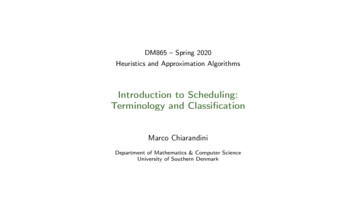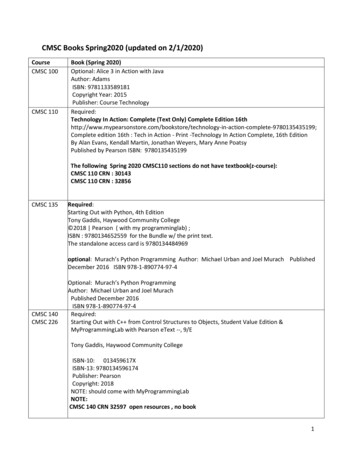
Transcription
DM865 – Spring 2020Heuristics and Approximation AlgorithmsIntroduction to Scheduling:Terminology and ClassificationMarco ChiarandiniDepartment of Mathematics & Computer ScienceUniversity of Southern Denmark
1. Definitions2. Classification3. Exercises4. Schedules2
1. Definitions2. Classification3. Exercises4. Schedules3
les Manufacturing Project planning Single, parallel machine and job shop systems Flexible assembly systemsAutomated material handling (conveyor system) Lot sizing Supply chain planning Services personnel/workforce scheduling public transports different models and algorithms4
DefinitionsClassificationExercisesSchedulesProblem Problem DefinitionGiven: a set of jobs J {J1 , . . . , Jn } to be processedby a set of machines M {M1 , . . . , Mm }.Task: Find a schedule, that is, a mapping of jobs to machines and processing times, that satisfiessome constraints and is optimal w.r.t. some criteria.Notation:n, j, k jobsm, i, h machines5
edulesScheduling are represented by Gantt charts(a) machine-oriented(b) job-oriented6
Data Associated to Jobs ing time pijRelease date rjDue date dj (called deadline, if strict)Weight wj Cost function hj (t) measures cost of completing Jj at t A job Jj may also consist of a number nj of operations Oj1 , Oj2 , . . . , Ojnj and data for eachoperation. A set of machines µjl M associated to each operation µjl 1 dedicated machines µjl M parallel machines µjl M multipurpose machinesData that depend on the schedule Starting times Sij Completion time Cij , Cj8
1. Definitions2. Classification3. Exercises4. Schedules9
Problem hedulesA scheduling problem is described by a triplet α β γ. α machine environment (one or two entries) β job characteristics (none or multiple entry) γ objective to be minimized (one entry)[R.L. Graham, E.L. Lawler, J.K. Lenstra, A.H.G. Rinnooy Kan (1979): Optimization and approximation indeterministic sequencing and scheduling: a survey, Ann. Discrete Math. 4, 287-326.]10
DefinitionsClassificationExercisesSchedulesα β γ Classification Schemeα1 α2 β1 . . . β13 γMachine Environment single machine/multi-machine (α1 α2 1 or α2 m) parallel machines: identical (α1 P ), uniform pj /vi (α1 Q), unrelated pj /vij (α1 R) multi operations models: Flow Shop (α1 F ), Open Shop (α1 O), Job Shop (α1 J),Mixed (or Group) Shop (α1 X), Multi-processor task sched.Single MachineFlexible Flow Shop(α F F c)Open, Job, Mixed Shop11
α β γ Classification SchemeJob chedulesα1 α2 β1 . . . β13 γ β1 prmp presence of preemption (resume) β2 precedence constraints between jobs acyclic digraph G (V, A) β2 prec if G is arbitrary β2 {chains, intree, outtree, tree, sp-graph} β3 rj presence of release dates β4 pj p preprocessing times are equal (β5 dj presence of deadlines) β6 {s-batch, p-batch} batching problem β7 {sjk , sjik } sequence dependent setup times12
α β γ Classification SchemeJob Characteristics (2)DefinitionsClassificationExercisesSchedulesα1 α2 β1 . . . β13 γ β8 brkdwn machine breakdowns β9 Mj machine eligibility restrictions (if α P m) β10 prmu permutation flow shop β11 block presence of blocking in flow shop (limited buffer) β12 nwt no-wait in flow shop (limited buffer) β13 recrc recirculation in job shop13
α β γ Classification �1 α2 β1 β2 β3 β4 γObjective (always f (Cj )) Lateness Lj Cj dj Tardiness Tj max{Cj dj , 0} max{Lj , 0} Earliness Ej max{dj Cj , 0} Unit penalty Uj 10if Cj djotherwise14
α β γ Classification �1 α2 β1 β2 β3 β4 γObjective Makespan: Maximum completion Cmax max{C1 , . . . , Cn }tends to max the use of machines Maximum lateness Lmax max{L1 , . . . , Ln } Total completion timePCj (flow time)Pwj · Cjtends to min the av. num. of jobs in the system, ie, work in progress, or also the throughputtimeP Discounted total weighted completion timewj (1 e rCj )P Total weighted tardinesswj · TjP Weighted number of tardy jobswj Uj Total weighted completion timeAll regular functions (nondecreasing in C1 , . . . , Cn ) except Ei15
α β γ Classification SchemeOther lesα1 α2 β1 β2 β3 β4 γNon regular objectivesP 0P Minwj Ej w”j Tj (just in time) Min waiting times Min set up times/costs Min transportation costs16
1. Definitions2. Classification3. Exercises4. Schedules17
es TSP: 1 sjk Cmax Knapsack: 1 dj d Pwj Uj Project planning (CPM, PERT): P prec Cmax Jm Cmax F m pij pj Cmax F Jc rj , sijk Pwj Tj 1 rj , prmtn Lmax18
1. Definitions2. Classification3. Exercises4. Schedules19
esDistinction between sequence schedule scheduling policyIf no preemption allowed, schedule defined by vector S (Si )Feasible scheduleA schedule is feasible if no two time intervals overlap on the same machine, and if it meets anumber of problem specific constraints.Optimal scheduleA schedule is optimal if it is feasible and it minimizes the given objective.20
Classes of esSemi-active scheduleA feasible schedule is called semi-active if no operation can be completed earlier without changing the orderof processing on any one of the machines. (local shift)Active scheduleA feasible schedule is called active if it is not possible to construct another schedule by changing the orderof processing on the machines and having at least one operation finishing earlier and no operation finishinglater. (global shift without preemption)Nondelay scheduleA feasible schedule is called nondelay if no machine is kept idle while an operation is waiting for processing.(global shift with preemption) There are optimal schedules that are nondelay for most models with regular objective function. There exists for Jm γ (γ regular) an optimal schedule that is active. nondelay active but active 6 nondelay21
DefinitionsClassificationExercisesSchedules22
SummaryDefinitionsClassificationExercisesSchedules Scheduling Definitions (jobs, machines, Gantt charts) Classification Classes of schedules23
DM865-Spring2020 HeuristicsandApproximationAlgorithms IntroductiontoScheduling: TerminologyandClassification MarcoChiarandini Department of Mathematics & Computer .

